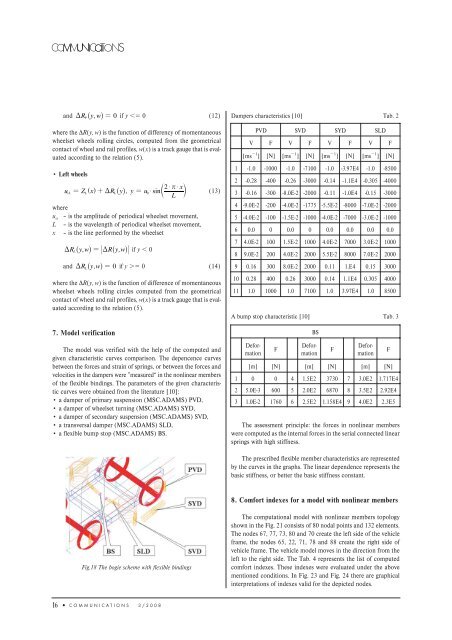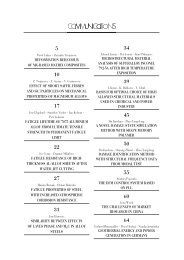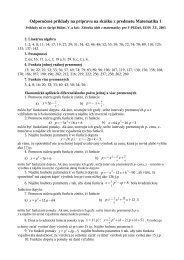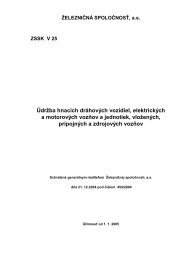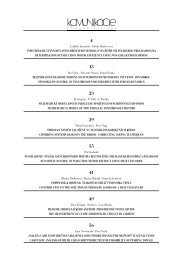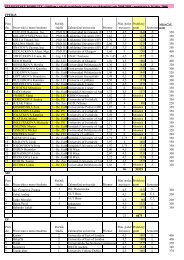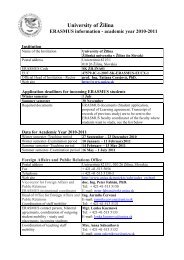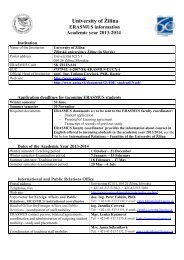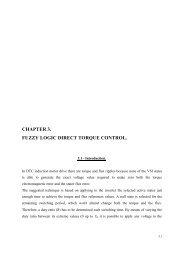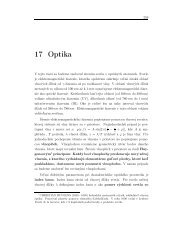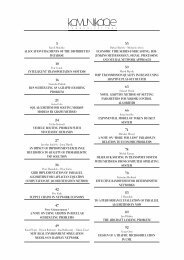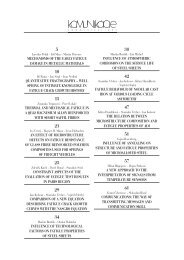simulation of torsion moment at the wheel set of the railway vehicle ...
simulation of torsion moment at the wheel set of the railway vehicle ...
simulation of torsion moment at the wheel set of the railway vehicle ...
Create successful ePaper yourself
Turn your PDF publications into a flip-book with our unique Google optimized e-Paper software.
and D R _ y,wi=0 if y 0 (12) Dampers characteristics [10] Tab. 2Pwhere <strong>the</strong> ΔR(y, w) is <strong>the</strong> function <strong>of</strong> differency <strong>of</strong> <strong>moment</strong>aneous<strong>wheel</strong><strong>set</strong> <strong>wheel</strong>s rolling circles, computed from <strong>the</strong> geometricalcontact <strong>of</strong> <strong>wheel</strong> and rail pr<strong>of</strong>iles, w(x) is a track gauge th<strong>at</strong> is evalu<strong>at</strong>edaccording to <strong>the</strong> rel<strong>at</strong>ion (5).• Left <strong>wheel</strong>s2 $ r $ xusL = Z ^ xh L + DRL _ yi, y = u0 $ sindnLwhereu o – is <strong>the</strong> amplitude <strong>of</strong> periodical <strong>wheel</strong><strong>set</strong> movement,L – is <strong>the</strong> wavelength <strong>of</strong> periodical <strong>wheel</strong><strong>set</strong> movement,x – is <strong>the</strong> line performed by <strong>the</strong> <strong>wheel</strong><strong>set</strong>DR _ y, wi=DR_y,wiLif y 0(13)and D R _ y,wi=0 if y 0 (14)where <strong>the</strong> ΔR(y, w) is <strong>the</strong> function <strong>of</strong> difference <strong>of</strong> <strong>moment</strong>aneous<strong>wheel</strong><strong>set</strong> <strong>wheel</strong>s rolling circles computed from <strong>the</strong> geometricalcontact <strong>of</strong> <strong>wheel</strong> and rail pr<strong>of</strong>iles, w(x) is a track gauge th<strong>at</strong> is evalu<strong>at</strong>edaccording to <strong>the</strong> rel<strong>at</strong>ion (5).7. Model verific<strong>at</strong>ionLThe model was verified with <strong>the</strong> help <strong>of</strong> <strong>the</strong> computed andgiven characteristic curves comparison. The depencence curvesbetween <strong>the</strong> forces and strain <strong>of</strong> springs, or between <strong>the</strong> forces andvelocities in <strong>the</strong> dampers were ”measured“ in <strong>the</strong> nonlinear members<strong>of</strong> <strong>the</strong> flexible bindings. The parameters <strong>of</strong> <strong>the</strong> given characteristiccurves were obtained from <strong>the</strong> liter<strong>at</strong>ure [10]:• a damper <strong>of</strong> primary suspension (MSC.ADAMS) PVD,• a damper <strong>of</strong> <strong>wheel</strong><strong>set</strong> turning (MSC.ADAMS) SYD,• a damper <strong>of</strong> secondary suspension (MSC.ADAMS) SVD,• a transversal damper (MSC.ADAMS) SLD,• a flexible bump stop (MSC.ADAMS) BS.PVD SVD SYD SLDV F V F V F V F[ms 1 ] [N] [ms 1 ] [N] [ms 1 ] [N] [ms 1 ] [N]1 -1.0 -1000 -1.0 -7100 -1.0 -3.97E4 -1.0 -85002 -0.28 -400 -0.26 -3000 -0.14 -1.1E4 -0.305 -40003 -0.16 -300 -8.0E-2 -2000 -0.11 -1.0E4 -0.15 -30004 -9.0E-2 -200 -4.0E-2 -1775 -5.5E-2 -8000 -7.0E-2 -20005 -4.0E-2 -100 -1.5E-2 -1000 -4.0E-2 -7000 -3.0E-2 -10006 0.0 0 0.0 0 0.0 0.0 0.0 0.07 4.0E-2 100 1.5E-2 1000 4.0E-2 7000 3.0E-2 10008 9.0E-2 200 4.0E-2 2000 5.5E-2 8000 7.0E-2 20009 0.16 300 8.0E-2 2000 0.11 1.E4 0.15 300010 0.28 400 0.26 3000 0.14 1.1E4 0.305 400011 1.0 1000 1.0 7100 1.0 3.97E4 1.0 8500A bump stop characteristic [10] Tab. 3FBSThe assessment principle: <strong>the</strong> forces in nonlinear memberswere computed as <strong>the</strong> internal forces in <strong>the</strong> serial connected linearsprings with high stiffness.FDeform<strong>at</strong>ionDeform<strong>at</strong>ionDeform<strong>at</strong>ion[m] [N] [m] [N] [m] [N]1 0 0 4 1.5E2 3730 7 3.0E2 1.717E42 5.0E-3 600 5 2.0E2 6870 8 3.5E2 2.92E43 1.0E-2 1760 6 2.5E2 1.158E4 9 4.0E2 2.3E5FThe prescribed flexible member characteristics are representedby <strong>the</strong> curves in <strong>the</strong> graphs. The linear dependence represents <strong>the</strong>basic stiffness, or better <strong>the</strong> basic stiffness constant.8. Comfort indexes for a model with nonlinear membersFig.18 The bogie scheme with flexible bindingsThe comput<strong>at</strong>ional model with nonlinear members topologyshown in <strong>the</strong> Fig. 21 consists <strong>of</strong> 80 nodal points and 132 elements.The nodes 67, 77, 73, 80 and 70 cre<strong>at</strong>e <strong>the</strong> left side <strong>of</strong> <strong>the</strong> <strong>vehicle</strong>frame, <strong>the</strong> nodes 65, 22, 71, 78 and 88 cre<strong>at</strong>e <strong>the</strong> right side <strong>of</strong><strong>vehicle</strong> frame. The <strong>vehicle</strong> model moves in <strong>the</strong> direction from <strong>the</strong>left to <strong>the</strong> right side. The Tab. 4 represents <strong>the</strong> list <strong>of</strong> computedcomfort indexes. These indexes were evalu<strong>at</strong>ed under <strong>the</strong> abovementioned conditions. In Fig. 23 and Fig. 24 <strong>the</strong>re are graphicalinterpret<strong>at</strong>ions <strong>of</strong> indexes valid for <strong>the</strong> depicted nodes.16 ● COMMUNICATIONS 3/2008


